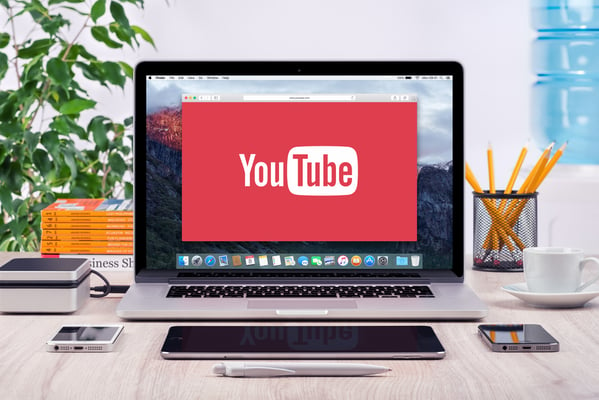Subscribe now and get the latest podcast releases delivered straight to your inbox.
Retailers' YouTube Ad Spend Drops 20% — What Does this Mean for YouTube Ads?

By Iris Hearn
Jul 2, 2019

Recent research from ad intelligence platform MediaRadar shows that retailers are spending less money on YouTube ads when compared to previous years.
Data showed that in the first five months of 2019, retail ad spend dropped 20% compared to the same timeframe last year.
Even with the sharp decrease, retail remains one of the top three advertiser categories on the platform (just behind media/entertainment and tech) — still, the drop does suggest that recent emerging digital ad formats offer more for retailers than YouTube video ads do.
As brands have more options for digital advertising than ever before, it’s likely we’ll continue to see increases and drops in specific categories on different ad platforms as companies learn which ad platforms offer a better return on ad spend.
Why Are Retail Sales Declining?
Speculations on this decline come down to two potential factors.
One reason is a reflection on hard times in the retail industry, as speculated by MediaRadar’s CEO Todd Krizelman. Krizelman cited the 7,000 retail companies set for closure in 2019 alone, furthering the idea of the “retail apocalypse” that continues to plague companies all over the world.
Essentially, the “retail apocalypse” is a recent phenomenon where smaller retail companies are being run out of business after losing sales to bigger companies that offer lower prices and more options.
For that reason, Krizelman does not blame YouTube specifically for the drop in ad sales, but rather, blames the fact that retail brands may not have the resources to invest heavily in YouTube ads.
The other reason for the sharp decline in ad spend is due to the emergence of more ad platforms over the past year that drive more value for retail companies.
For example, Instagram ads have significantly expanded their options over the last year, and these are only expected to get additional developments, like product tags and an in-app checkout, extended to all brands soon.
Another leader in retail sales is Amazon, who has quickly grown to be the third most popular ad platform in the past year. Because the nature of Amazon’s platform is more buying-centric, advertising on the platform presents a better opportunity for marketers to reach consumers actively looking to discover and purchase new products.
In fact, recent research shows that Amazon advertising can have a significant impact in driving non-Amazon sales, which is ideal for retailers looking to boost sales on and off the platform.
Both of these platforms offer advertising options that are more closely aligned to helping retailers sell merchandise than YouTube’s video and display ads. The emergence of these alternatives offers a pretty convincing explanation behind the significant drop in sales over the last year.
After all, if brands have noticed another ad option can get them closer to their end goal, many are more likely to choose the new options avaliable.
So, is YouTube dying as an ad platform?
Despite the sharp decline in retail ad spend, I’d say that YouTube’s ad platform is far from dying.
Rather, I believe that advertisers are simply gaining a better sense of what works best for their particular product or service.
While there may be better options out there for retail ads, YouTube saw a 3% increase in ad sales for media and entertainment companies, as well as better performance for tech companies.
In fact, Mobile Marketer reported that half of the channel’s revenue this year comes from tech and media/entertainment companies.
For the platform, this makes sense. If you’re a media company looking to boost engagement with your content, advertising on a platform where people go to view content of interest to them is much more likely to resonate.
On the tech side, it makes sense too. While “tech” can cover a large array of businesses, as a whole, tech industries tend to sell products with longer buying cycles that are designed to solve a specific need.
Software products, for example, tend to have longer buying cycles. As such, running ads on YouTube can increase brand awareness, ad recall, and overall help users potentially get to know your product, even if they’re not “ready to buy” at the first time they view the ad.
Instead, the goals of the campaign might be to familiarize consumers with the product, so if they’re actively looking to buy in the future, they’ll already be familiar with a solution.
YouTube is not a dying ad platform — this data just means that YouTube is clearly best suited for specific products or industries.
Why is this important for marketers?
With every emerging ad platform, marketers will often be told they “have to test” this new trend.
In reality, this just isn’t true.
Your ad results are only going to be as good as your overall strategy. By blindly investing in new ad platforms in an attempt to tackle your audience from all angles, you won’t be “foolproofing” your tactics.
While experimentation is always great, it’s important to monitor the data out there and think about your ideal customer, their mindset when seeing the ad, and what your goals for your ad campaign are.
For example, if you’re looking to build awareness and boost ad recall and familiarity with your product, YouTube ads can be a great option.
However, if you’re looking to directly impact bottom-line sales with your ad spend, you’re better off going for a more direct option like Amazon, Pinterest, Instagram, or other more merchandise-focused platforms.
Keeping up with trends like this is a great way to learn from other brands on what had or had not been working for them. By following these insights, brands can get a sense of what ad platforms will yield the best results without going through the trial and error process.
Free Assessment: